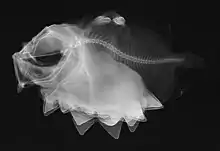Oreosoma atlanticum
Oreosoma atlanticum, also known as the ox-eyed oreo, is a species of oreo found in oceanic deep waters. It is the only known member of its genus. Although adults are more similar in shape to other oreos, the juveniles have a distinctive plating/armor in their skin, which is spiked and probably makes them harder to eat for any hostile creature. Adults lack that plating, and, as other oreos, they have a protractile mouth and very large eyes, with small scales.
| Oreosoma atlanticum | |
|---|---|
 | |
 | |
| Oreosoma atlanticum, conventional and X-ray images | |
| Scientific classification | |
| Domain: | Eukaryota |
| Kingdom: | Animalia |
| Phylum: | Chordata |
| Class: | Actinopterygii |
| Order: | Zeiformes |
| Family: | Oreosomatidae |
| Subfamily: | Oreosomatinae |
| Genus: | Oreosoma G. Cuvier, 1829 |
| Species: | O. atlanticum |
| Binomial name | |
| Oreosoma atlanticum G. Cuvier, 1829 | |
Description
This species grows to a length of 21 cm (8.3 in). The adults are deep bodied and laterally compressed with a strongly humped back They have a small head with large eyes.[1]
The juveniles are dark grey or black in colour with rounded white blotches. Their fins are translucent. They have a rounded stomach with two rows of cone-shaped protrusions. They have another four rows of similar protrusions along their backs. These projections make them highly distinctive.[1]
Distribution and habitat
This species is found at depths of 220 to 1,550 m (720 to 5,090 ft).[1]
_(14781511772).jpg.webp)
References
- Froese, Rainer; Pauly, Daniel (eds.) (2012). "Oreosoma atlanticum" in FishBase. October 2012 version.
- Zsilavecz, Guido (2005). Coastal fishes of the Cape Peninsula and False Bay : a divers' identification guide. Cape Town: Southern Underwater Research Group. ISBN 0-620-34230-7. OCLC 70133147.
 Media related to Oreosoma atlanticum at Wikimedia Commons
Media related to Oreosoma atlanticum at Wikimedia Commons